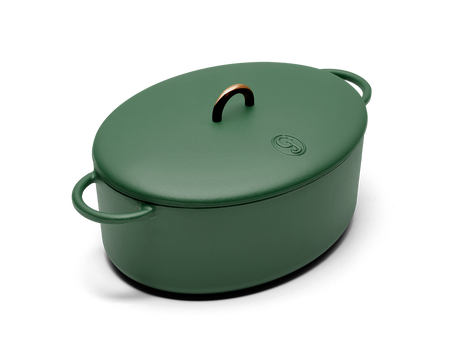Great Ones is a celebration of humans we admire — and an exploration of why they cook, not just how. Zaynab Issa is a writer and recipe developer based in New York. We spent an afternoon together making her family’s take on waliamboga and discussed how she reconnected with her heritage through the process of making her (now-digital) cookbook, Let’s Eat.
Growing up, I didn’t realize that not being interested in cooking was an option. My grandma lived with us, and she is an incredible cook. She came from a farming family in East Africa, so her love for food is rooted in a deep appreciation for the ingredients themselves.
Indians in East Africa are longstanding, and while there are points in history where the migration influx had to do with British colonization of India and East Africa, there were also predating trade routes that played a role. There were the Indian Ocean trade routes that connected the Middle East, India, China, and coastal East Africa. A lot of the flavors and cultural influences in the region came from that.
I didn’t realize that not being interested in cooking was an option.

As far as I know, both of my parents are entirely of Indian descent. Their families lived in East Africa as far back as five generations. My dad is from Zanzibar, an island off the coast of Tanzania, and my mom is from Lindi, a more rural community on the outskirts of the city. They eventually moved to a small town in New Jersey, where I was raised.
I grew up in a predominantly white town, and my parents were much more conservative back then. They really didn’t want us to go out much, so my idea of an activity was helping my grandma out in the kitchen. She cooked predominantly East African–Indian food. The idea that we didn’t have pasta for dinner every night was so interesting to anyone that I would bring over.
Even to this day, the process is still my favorite part of cooking.

I grew up eating kuku paka a lot — it’s an East African coconut curry with chicken that’s eaten with rice. It’s so good! We would also make tameta nu saag, which is basically spiced tomatoes and onions cooked down that we would make in bulk and then freeze to use when people came over. I remember them bringing back a huge carton of tomatoes from the market, and I would have to dice every single one of them. I remember that my fingers would be so wrinkly afterward, but, honestly, I looked forward to it. Even to this day, the process is still my favorite part of cooking.
For a long time, I was so interested in everybody else's food.
For a long time, I was so interested in everybody else's food. Anytime I was in control of what I was eating or could eat out, I wanted bagels, pasta, sushi — you name it. There was always an inclination toward that. My appreciation always sat with what other people had deemed interesting, like brunch or avocado toast — which I still love, but it’s not the only thing that there is to love.

I think it took me longer than I want to admit to realize that there is value in everything — everybody’s perspectives and preferences (including mine), and that trying them can be interesting. Part of it can be scary, especially when you’re introducing something new. But that’s why, with my cookbook, I tried to break everything down so it was digestible and accessible, without losing sight of what the dish really is.
My culture is a minority within a minority.
The cookbook started out as a thesis art project in early 2020. Right before the pandemic, the word polarized was being thrown around left, right, and center. I wanted to take that word and think about how you connect people and bridge gaps, and food is the answer to me — period. Everybody needs to eat, so there is really no better way to bring people together, build understanding, and to take the time to learn about another person and where they come from.

In conjunction with that, my culture is a minority within a minority. I am not Indian, I’m not East African — I’m East African–Indian, and there is so much culinary history there that is untapped. There are so few written recipes, and I really wanted to formalize these dishes that I grew up eating so they could be shared. A big part of representation is seeing other people experience and enjoy what you are familiar with, and this subset of Indian or East African food was not being highlighted.
I really wanted to formalize these dishes that I grew up eating so they could be shared.
I wanted to write this cookbook about connecting people and the role food plays in that — and, at the same time, dive into my culture, which I had largely ignored for a majority of my life because I had wanted to distance myself from it. It was not something I saw in the world, so I didn’t think it was normal to be different — especially growing up as one of maybe five people of color in my school. It wasn’t something I was proud of during my childhood, and I finally wanted to own it. This cookbook is me putting a piece of myself out on the table.

As I’ve explored my own culinary roots, I’ve gained comfort, for sure. I just feel so settled in myself, in a weird way. I think it’s because I’ve finally come to terms with the fact that this is a big part of my identity, which I pushed to the side for so long. There’s an overwhelming grounding in who I am, and it’s pushed me to see that we can embrace our differences and recognize our similarities, and that is why humanity is beautiful. No two people are as different as they might seem, and food can create space for us to see those similarities.
This cookbook is me putting a piece of myself out on the table.
In terms of representation, I try to do my best, but nobody is perfect, and it’s important to remember that, too. The best people to be telling these stories are those that experience them firsthand. For example, my parents’ struggle is so different from my struggle. Ultimately, I’m trying to communicate something that is not mine firsthand; my experience with this heritage is diluted, but when it comes to representation, there is always this pressure to tell this full story that I’ll never be able to tell. I can only tell you my story, but ultimately each of those stories is going to teach you that we’re all human and we’re all going through something.
No two people are as different as they might seem, and food can create space for us to see those similarities.

Today I made my grandmother’s take on an East African dish called waliamboga (or Wali-YUM-boga, as I like to say — cheesy, but true). This dish feeds a lot of people. If a recipe makes a lot, you’re not mad and everyone is fed and happy, and there’s a catalyst for conversation already.
It’s a true blend of the two cuisines.
Waliamboga, in the most traditional sense, is definitely a bit drier than the one I’ve made today. This one has tomatoes and spices, and it’s a true blend of the two cuisines. There’s coriander, turmeric, and chili powder — classic Indian flavors — and then spinach, rice, and chicken. It’s super bright and flavorful. You can serve it with yogurt and kachumber (pickled onions, cucumbers, and tomatoes — or, really, any combination of salt, acid, and something crunchy).

I consider this the East African version of biryani.
This dish can be made entirely in The Dutchess and then served in it, too, because it’s gorgeous — talk about easy. I like the fact that The Dutchess is oven-safe, because there is an optional step to steam the dish in the oven for ten minutes so the flavors can settle. I consider this the East African version of biryani in the way my grandmother makes it — it hits the same spot for me. There’s the spices, caramelized onions, and the chicken is super tender.
I think this could be adapted to a vegan or vegetarian diet; it would be amazing with cauliflower or sweet potato. It’s a beautiful dish and so elegant — a wonderful display of the melding of the two cuisines.
























